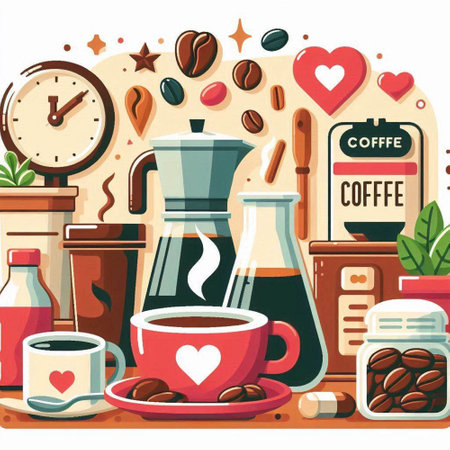1. Understanding Decaffeinated Coffee: What Is It Really?
When it comes to decaffeinated coffee, confusion and misconceptions are common in the U.S. Many Americans assume “decaf” means caffeine-free, but thats not scientifically accurate. Decaffeination is a meticulous process that removes most—but not all—of the caffeine from coffee beans. In the United States, according to the Food and Drug Administration (FDA) and industry standards, coffee labeled as “decaffeinated” must have at least 97% of its original caffeine content removed. This leaves a small amount of caffeine behind—typically about 2 to 5 milligrams per 8-ounce cup, compared to 70-140 milligrams in regular coffee.
The decaffeination process itself involves several methods, including water processing, solvent-based extraction (using substances like ethyl acetate or methylene chloride), and carbon dioxide techniques. Each method aims to minimize flavor loss while efficiently extracting caffeine from green coffee beans before they’re roasted. These processes are rigorously regulated in the U.S. to ensure both safety and quality for consumers. Ultimately, understanding what counts as “decaf” helps debunk myths and sets realistic expectations for those seeking low-caffeine options without compromising on taste or safety.
2. Does Decaf Mean Caffeine-Free? The Science Behind the Label
One of the most persistent misconceptions about decaffeinated coffee in the United States is that “decaf” automatically means zero caffeine. However, from a scientific and regulatory perspective, this assumption doesn’t hold up. In reality, decaf coffee still contains trace amounts of caffeine—enough to be measurable and sometimes enough to affect sensitive individuals.
The Chemistry of Decaffeination
Decaffeination is a process designed to remove most, but not all, of the caffeine from coffee beans. According to U.S. Food and Drug Administration (FDA) standards, at least 97% of the original caffeine must be removed for a product to be labeled as “decaffeinated.” The remaining caffeine content varies depending on the method used and the type of coffee bean.
How Much Caffeine Remains?
The actual amount of caffeine in a cup of decaf can surprise many Americans who are seeking a completely caffeine-free option. Let’s break down the typical caffeine levels found in regular versus decaf coffee in the U.S.:
| Beverage | Average Caffeine Content (per 8 oz cup) |
|---|---|
| Regular Brewed Coffee | 95 mg |
| Decaf Brewed Coffee | 2–5 mg |
Cultural Implications: Why This Matters
For most people, the low levels of caffeine in decaf are insignificant, but for those with high sensitivity or specific health conditions—such as heart arrhythmias or pregnancy—the difference between “caffeine-free” and “almost caffeine-free” is important. American consumers often overlook these subtle distinctions due to marketing language and common usage, which can lead to confusion and unintended caffeine consumption.
In summary, understanding that decaf coffee in the U.S. isn’t entirely caffeine-free empowers consumers to make more informed choices based on their unique health needs and lifestyle preferences.

3. Health Benefits and Risks: Separating Fact from Fiction
When it comes to decaffeinated coffee, opinions are split—some Americans believe it’s a healthier alternative, while others worry about potential drawbacks. To clarify these concerns, let’s examine the latest scientific evidence regarding the health benefits and risks associated with drinking decaf.
Potential Heart Health Impacts
One of the most common questions is whether decaf coffee affects cardiovascular health. Recent studies conducted by reputable institutions such as the American Heart Association suggest that moderate consumption of decaf may offer some protective benefits similar to regular coffee. For example, compounds like antioxidants and polyphenols remain present after decaffeination, which can help reduce inflammation and improve blood vessel function. However, some research has indicated that certain chemical solvents used in older decaffeination processes might have raised cholesterol levels, though this is less of a concern today as most U.S. brands utilize safer water-based or CO2 methods.
Sleep Patterns and Caffeine Sensitivity
For many Americans, one appeal of decaf is the ability to enjoy coffee flavor without the jitters or sleep disturbances caused by caffeine. Scientific reviews show that while trace amounts of caffeine remain in decaf, they are typically low enough not to disrupt sleep for most people. That said, individuals who are highly sensitive to caffeine should still be mindful; even small quantities could potentially impact their sleep quality or contribute to restlessness if consumed late in the day.
Other Health Considerations
The myth that decaf coffee is devoid of nutritional value is unfounded. Decaf retains beneficial micronutrients such as magnesium and potassium, supporting overall wellness. On the flip side, excessive consumption—just like with regular coffee—can lead to digestive discomfort or heartburn in susceptible individuals due to natural acids in coffee beans.
The Takeaway for U.S. Coffee Drinkers
Ultimately, recent research dispels many outdated myths about decaf. When sourced from reputable brands using modern processing methods, decaf can be a safe choice that delivers much of the pleasure and health potential of regular coffee, with fewer sleep-related risks. As with any dietary habit, moderation remains key to maximizing benefits while minimizing adverse effects.
4. Decaf Coffee and Chemical Processing: Are There Safety Concerns?
One of the most common concerns among American coffee drinkers revolves around the chemicals used in the decaffeination process. Many people worry that these methods leave behind harmful residues that could pose health risks. Lets break down how decaf coffee is made, address the safety of chemical processing, and examine what regulations are in place in the U.S. to protect consumers.
How Is Coffee Decaffeinated?
There are several methods to remove caffeine from coffee beans. The two main chemical-based processes are the Direct Solvent Method and the Indirect Solvent Method, both commonly using methylene chloride or ethyl acetate. Additionally, there are non-chemical methods such as the Swiss Water Process and Carbon Dioxide Process. Here’s a quick comparison:
| Decaffeination Method | Chemicals Used | Residue Risk |
|---|---|---|
| Direct Solvent (Methylene Chloride) | Methylene Chloride | Extremely Low (Regulated) |
| Indirect Solvent (Ethyl Acetate) | Ethyl Acetate | Extremely Low (Regulated) |
| Swiss Water Process | No Chemicals | None |
| CO2 Process | No Harmful Chemicals | None |
Addressing Fears About Chemical Residues
The U.S. Food and Drug Administration (FDA) tightly regulates the use of solvents like methylene chloride in food processing. For example, the FDA limits methylene chloride residue in decaf coffee to a maximum of 10 parts per million (ppm), a level considered safe based on scientific evidence. Most commercially available decaf coffee contains residue levels far below this limit—often undetectable with standard testing equipment.
U.S. Regulations Ensuring Decaf Coffee Safety
- The FDA monitors and enforces strict residue limits for all approved solvents.
- Coffee manufacturers must comply with Good Manufacturing Practices (GMP) to minimize any risk of contamination.
- Regular inspections and random sampling help ensure ongoing compliance and public safety.
The Bottom Line for American Consumers
Scientific research and government oversight have shown that decaffeinated coffee sold in the United States is safe for consumption, even when produced using chemical solvents. If you prefer to avoid chemicals entirely, options like Swiss Water Process or CO2 Process are widely available at supermarkets and cafes across the country. Ultimately, whether you choose chemically processed or chemical-free decaf, you can sip your cup with confidence knowing it meets rigorous U.S. safety standards.
5. Taste Test: Does Decaf Compromise Flavor?
The flavor of coffee is a topic of passionate debate across the United States, and decaf is no exception. One of the most persistent myths is that decaffeinated coffee inevitably tastes inferior to its caffeinated counterpart. But is this reputation justified? To answer this, we turned to the real experts: American baristas and devoted coffee enthusiasts.
Barista Perspectives on Decaf Flavor
Across the specialty coffee scene from Seattle to New York City, many baristas report that modern decaffeination techniques—like the Swiss Water Process and CO2 extraction—have dramatically improved decaf’s taste profile. These methods remove caffeine with minimal impact on the flavor compounds that give coffee its signature aroma and complexity. As one Portland barista explained, “With quality beans and careful preparation, most customers can’t tell the difference in a blind tasting.”
Coffee Enthusiasts Weigh In
Coffee lovers from Los Angeles to Chicago also share mixed experiences. While some long-time aficionados argue that they can detect subtle differences, many admit that advances in roasting and brewing have closed the gap between regular and decaf. In fact, several U.S. coffee competitions now feature decaf categories, challenging participants to identify which cup lacks caffeine—and results show that even experts are often stumped.
The Role of Bean Quality and Freshness
Ultimately, both professionals and consumers agree: flavor comes down to bean quality, roast level, and freshness more than caffeine content. Many premium American coffee roasters now offer single-origin decafs roasted with as much care as their regular offerings. This shift reflects changing attitudes—decaf is no longer an afterthought but a viable option for those seeking great taste without the buzz.
In summary, while old-school decafs might have left a bitter memory, today’s decaffeinated coffees can deliver full-bodied flavor and complexity. The myth that all decaf tastes bad simply doesn’t hold up under scrutiny—or a thorough taste test.
6. Who’s Drinking Decaf? U.S. Trends and Cultural Shifts
As we debunk the myths surrounding decaffeinated coffee in the U.S., it’s crucial to understand who actually drinks decaf and how perceptions are shifting. Traditionally, decaf was associated with older adults or those with health sensitivities, but recent trends reveal a broader, more diverse group embracing this option. From Millennials focused on wellness to Gen Zers seeking mindful consumption, decaf is shedding its reputation as a last resort and gaining ground as a conscious lifestyle choice.
The Rise of Health-Conscious Consumers
In today’s American culture, health is front and center. Many consumers are cutting back on caffeine for reasons ranging from anxiety management to better sleep hygiene. Decaf has become a go-to for those who want to enjoy the ritual and flavor of coffee without the jitters or late-night restlessness. This shift is reflected in coffee shop menus nationwide, where specialty decaf options are now standard rather than an afterthought.
Diversity in Demographics
It’s not just one demographic driving the decaf trend. Busy professionals, pregnant women, athletes, and even college students studying late all find value in decaffeinated choices. Data from market research firms shows a steady uptick in decaf sales across age groups and regions, especially in urban areas where wellness trends take root quickly.
Mainstream Acceptance: From Stigma to Status Symbol
Perhaps most telling is how mainstream attitudes have evolved. Once stigmatized as “not real coffee,” decaf is now seen as an informed, intentional choice—sometimes even a status symbol among wellness enthusiasts. Influencers and celebrities often spotlight their favorite caffeine-free blends on social media, further normalizing and glamorizing the switch.
The Future of Decaf Culture in America
Looking ahead, the American love affair with coffee isn’t fading—it’s simply evolving. As science continues to clarify the safety and benefits of decaf, and as innovative roasting techniques improve flavor profiles, expect even more people to reach for that second (or third) cup without hesitation. The myths may persist in some circles, but for many Americans, decaf coffee is no longer just an alternative; it’s a preferred part of everyday life.

